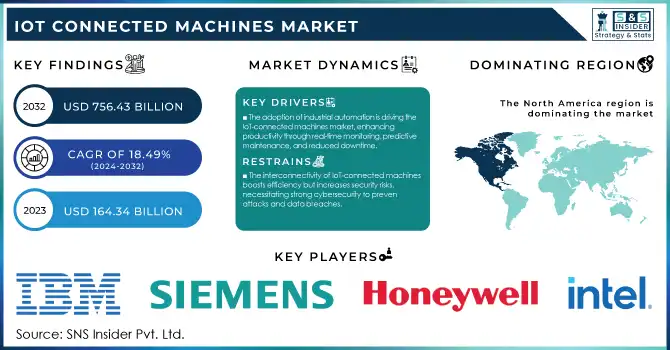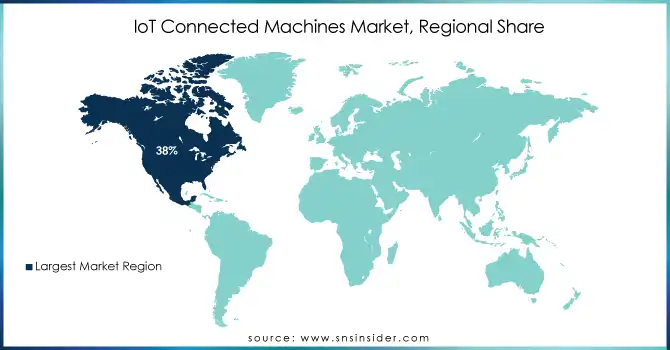IoT Connected Machines Market Size:
The IoT Connected Machines Market Size was valued at USD 164.34 Billion in 2023 and is expected to increase to USD 756.43 Billion by 2032, expanding at a CAGR of 18.49% between 2024 and 2032.
The IoT Connected Machines Market is experiencing significant growth driven by the increasing adoption of Internet of Things (IoT) technologies across industries. Organizations are increasingly integrating IoT solutions into their machines to enable real-time monitoring, predictive maintenance, and enhanced operational efficiency. This transformation is particularly visible in sectors like manufacturing, automotive, healthcare, and logistics, where IoT-connected machines can optimize workflows, reduce downtime, and improve asset management.

Get More Information on IoT Connected Machines Market - Request Sample Report
These smart machines are equipped with sensors, software, and connectivity capabilities, allowing them to transmit data back to centralized systems for analysis and actionable insights. One of the primary trends driving the market is the rise of Industry 4.0, where smart factories leverage IoT-enabled devices to streamline processes and improve production quality. This trend is accompanied by the growing emphasis on automation, which benefits from the data generated by IoT-connected machines, enabling more informed decision-making and improved process control. Additionally, the increasing focus on sustainability and reducing environmental impact has encouraged the adoption of IoT machines to monitor energy consumption and reduce waste.
Another important trend is the integration of AI and machine learning with IoT-connected machines. This combination enhances predictive capabilities, allowing for proactive maintenance and reducing the likelihood of machine failure. Furthermore, the expanding ecosystem of cloud computing and 5G connectivity is fueling the expansion of IoT-connected devices, offering faster data transmission and broader connectivity options. With the proliferation of smart devices and the expansion of IoT networks, businesses are not only improving machine performance but also unlocking new opportunities for innovation and growth. These advancements are contributing to the ongoing digital transformation of industries, helping companies achieve greater productivity, safety, and cost-efficiency. The market continues to evolve with the development of new IoT solutions and platforms, meeting the increasing demand for smarter, more connected systems.
IoT Connected Machines Market Dynamics
DRIVERS
-
The growing adoption of industrial automation, driven by the need for operational efficiency, is propelling the IoT-connected machines market, with real-time monitoring, predictive maintenance, and reduced downtime leading to improved productivity and cost savings.
The growing adoption of industrial automation is a key driver of the IoT-connected machines market. As industries worldwide seek to improve operational efficiency, they increasingly turn to automation technologies. IoT-connected machines, which integrate sensors, connectivity, and data analytics, offer real-time monitoring of equipment performance, allowing businesses to identify issues before they escalate. This proactive approach enables predictive maintenance, where potential failures are detected early, minimizing unplanned downtime and extending the lifespan of machinery. by reducing unexpected breakdowns, companies can improve overall productivity and avoid costly repairs. Moreover, automation reduces the need for manual labor in routine monitoring and control, freeing up resources for more value-added tasks. As a result, businesses can cut operational costs and improve profitability. The ongoing development of advanced connectivity technologies, such as 5G, further accelerates the adoption of these IoT solutions, promising even greater automation capabilities and integration in the years ahead.
RESTRAIN
-
The increased interconnectivity of IoT-connected machines enhances operational efficiency but also heightens security risks, requiring robust cybersecurity measures to protect against cyberattacks and data breaches.
As IoT-connected machines become more prevalent across industries, they significantly increase the interconnectivity of systems, leading to greater operational efficiencies and innovations. However, this also heightens the risk of cyberattacks and data breaches. With machines sharing sensitive data and integrating with cloud systems or external devices, they become potential entry points for malicious actors looking to exploit vulnerabilities. A compromised IoT system could lead to serious repercussions, including unauthorized access to proprietary data, production disruptions, and even physical harm in certain sectors. The sheer scale of connected devices further complicates the issue, as ensuring the security of each individual device and the overall network can be overwhelming for organizations.
To mitigate these risks, robust cybersecurity measures are essential. Organizations must implement comprehensive strategies that include encryption, authentication, and continuous monitoring to detect unusual activities. Additionally, regular software updates and patches are critical to safeguard against known vulnerabilities. However, many organizations, particularly smaller ones, struggle to maintain the necessary resources or expertise to address these security concerns effectively. This gap in security preparedness can lead to vulnerabilities that cybercriminals can exploit, potentially leading to significant financial and reputational damage.
IoT Connected Machines Market Key Segmentation
by Component
IoT Gateways segment dominated with the market share over 42% in 2023, due to their vital role in facilitating communication between machines and networks. Acting as intermediaries, IoT Gateways enable seamless data transfer from machines to the cloud, ensuring real-time monitoring and control. They convert machine data into a format that can be transmitted across various network protocols, allowing for interoperability between devices from different manufacturers. Additionally, IoT Gateways manage security by encrypting the data before transmission, ensuring safe and reliable data transfer. Their ability to integrate with various machine types and network systems makes them essential in industrial, automotive, and other sectors adopting IoT solutions.
by Industry
The manufacturing segment dominate with the market share over 25% in 2023, driven by the widespread adoption of IoT technologies. In manufacturing, IoT devices are primarily utilized for predictive maintenance, enabling companies to anticipate equipment failures before they occur, reducing downtime and repair costs. Additionally, IoT solutions help optimize operational efficiency by providing real-time insights into production processes, inventory management, and machine performance. These connected machines facilitate seamless data flow between machines, operators, and systems, allowing manufacturers to make data-driven decisions that improve productivity and reduce waste. Furthermore, IoT enables smart factories, where automation and remote monitoring are key components in enhancing operational agility and reducing manual labor.
IoT Connected Machines Market Regional Analysis:
North America region dominated with the market share over 38% in 2023, driven by its advanced technological infrastructure and early adoption of IoT solutions. The region's robust industrial sector, particularly in the United States and Canada, has rapidly integrated IoT technologies across various industries such as manufacturing, automotive, and logistics. The presence of key industry players, including technology giants and IoT solution providers, further strengthens North America's leadership in the market. These companies have led the way in deploying smart machines and connected devices, enabling enhanced automation, data analytics, and efficiency in operations. Additionally, the region's favorable government policies, investments in research and development, and strong cybersecurity frameworks have contributed to the widespread adoption of IoT technologies.
Asia-Pacific is experiencing rapid growth in the IoT Connected Machines Market, primarily due to its ongoing industrialization and technological advancements. Countries like China, India, and Japan are at the forefront of adopting IoT solutions across various sectors, including manufacturing, automotive, and healthcare. The region's expanding industrial base is increasingly leveraging IoT technologies to enhance operational efficiency, reduce costs, and improve product quality. Additionally, government initiatives and policies that promote smart city development and digital transformation have further accelerated IoT adoption.

Need any customization research on IoT Connected Machines Market - Enquiry Now
Some of the major key players of IoT Connected Machines Market
-
IBM Corporation (Watson IoT, IBM Maximo)
-
Siemens AG (MindSphere, Industrial IoT)
-
Honeywell International Inc. (Honeywell Connected Plant, IoT for Industrial Applications)
-
Intel Corporation (Intel IoT Solutions, Intel IoT Platform)
-
General Electric Company (Predix, Industrial Internet of Things)
-
Hitachi Ltd. (Lumada, IoT Data Management)
-
PTC Ltd. (ThingWorx, IoT Application Enablement Platform)
-
ABB Ltd. (ABB Ability, IoT Solutions for Industry)
-
Rockwell Automation (FactoryTalk InnovationSuite, Connected Enterprise)
-
Schneider Electric (EcoStruxure, IoT-enabled Energy Management Solutions)
-
Cisco Systems Inc. (Cisco IoT, IoT Connectivity Solutions)
-
Microsoft Corporation (Azure IoT, Microsoft IoT Solutions)
-
Qualcomm Inc. (Qualcomm IoT, IoT Chipsets)
-
Oracle Corporation (Oracle IoT Cloud, IoT Fleet Management)
-
Amazon Web Services (AWS) (AWS IoT Core, AWS IoT Analytics)
-
Bosch Software Innovations (Bosch IoT Suite, Industrial IoT Platforms)
-
Ericsson AB (Ericsson IoT Accelerator, IoT Connectivity Solutions)
-
Arm Holdings (Arm IoT Solutions, Arm Mbed)
-
NXP Semiconductors (NXP IoT Solutions, IoT Processors)
-
SAP SE (SAP Leonardo IoT, SAP Cloud Platform IoT)
Suppliers (industrial IoT solutions that include connected machines for predictive maintenance, automation, and real-time monitoring) IoT Connected Machines Market
-
Siemens AG
-
GE Digital
-
Honeywell International Inc.
-
Bosch IoT
-
IBM
-
Rockwell Automation
-
Cisco Systems, Inc.
-
Microsoft Corporation
-
PTC Inc.
-
Schneider Electric
Recent Development
In June 2024: Siemens explores how the concept of the digital twin is transforming industries through the Internet of Things (IoT). A digital twin is a virtual representation of physical assets, enabling real-time data analysis, simulation, and optimization. by integrating IoT technology, businesses can enhance efficiency, minimize downtime, and create smart factories. This advancement is pivotal across sectors like manufacturing, space missions, and energy management.
In January 2024: IBM and American Tower have partnered to enhance edge cloud services, aiming to transform industries by bringing cloud capabilities closer to IoT devices and edge servers. This collaboration will enable enterprises, particularly in automotive, to deploy applications at scale, leveraging technologies like 5G, AI, and network automation. The initiative also allows for faster data processing and software updates, improving operational efficiency and addressing data security and compliance needs.
| Report Attributes | Details |
|---|---|
| Market Size in 2023 | USD 164.34 Billion |
| Market Size by 2032 | USD 756.43 Billion |
| CAGR | CAGR of 18.49% From 2024 to 2032 |
| Base Year | 2023 |
| Forecast Period | 2024-2032 |
| Historical Data | 2020-2022 |
| Report Scope & Coverage | Market Size, Segments Analysis, Competitive Landscape, Regional Analysis, DROC & SWOT Analysis, Forecast Outlook |
| Key Segments | • By Component (IoT Gateways, I/O Modules, IoT Sensors, Others [PLCs]) • By Industry (Automotive, Aerospace & Defense, Logistics & Transportation, Manufacturing, Power and Utilities, Healthcare, Oil & Gas, Others [Chemical]) |
| Regional Analysis/Coverage | North America (US, Canada, Mexico), Europe (Eastern Europe [Poland, Romania, Hungary, Turkey, Rest of Eastern Europe] Western Europe] Germany, France, UK, Italy, Spain, Netherlands, Switzerland, Austria, Rest of Western Europe]), Asia Pacific (China, India, Japan, South Korea, Vietnam, Singapore, Australia, Rest of Asia Pacific), Middle East & Africa (Middle East [UAE, Egypt, Saudi Arabia, Qatar, Rest of Middle East], Africa [Nigeria, South Africa, Rest of Africa], Latin America (Brazil, Argentina, Colombia, Rest of Latin America). |
| Company Profiles | IBM Corporation, Siemens AG, Honeywell International Inc., Intel Corporation, General Electric Company, Hitachi Ltd., PTC Ltd., ABB Ltd., Rockwell Automation, Schneider Electric, Cisco Systems Inc., Microsoft Corporation, Qualcomm Inc., Oracle Corporation, Amazon Web Services (AWS), Bosch Software Innovations, Ericsson AB, Arm Holdings, NXP Semiconductors, SAP SE. |
| Key Drivers | • The growing adoption of industrial automation, driven by the need for operational efficiency, is propelling the IoT-connected machines market, with real-time monitoring, predictive maintenance, and reduced downtime leading to improved productivity and cost savings. |
| RESTRAINTS | • The increased interconnectivity of IoT-connected machines enhances operational efficiency but also heightens security risks, requiring robust cybersecurity measures to protect against cyberattacks and data breaches. |

